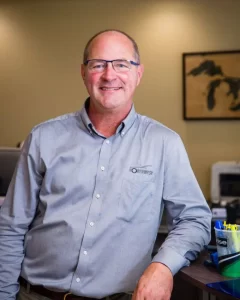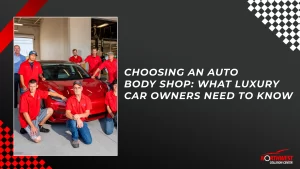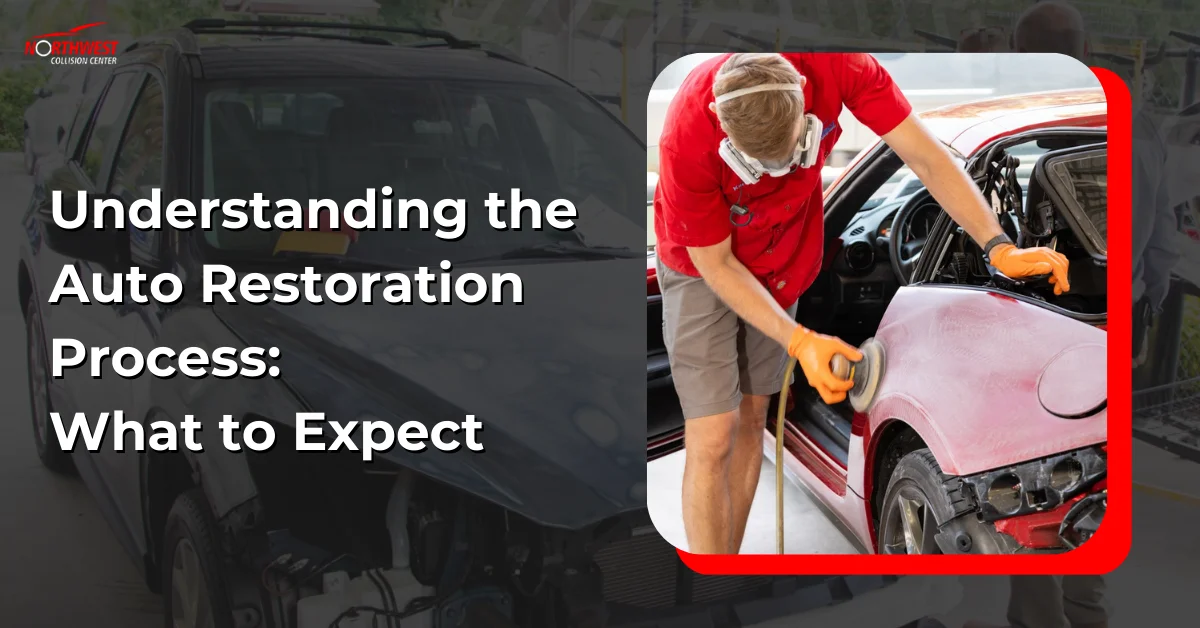To tackle affordable DIY auto body repairs, you’ll need crucial tools like sanders, body hammers, and quality fillers. Start by thoroughly inspecting your vehicle for damage, noting misalignments and paint inconsistencies. Small dents can be pulled with a dent puller and refined with sandpaper and body filler. Scratches require cleaning, depth assessment, and precise touch-up paint application. For replacing panels, verify compatibility and alignment, using clamps and proper fastening techniques. Finally, achieve a polished finish with a dual-action polisher and quality wax. Following these steps guarantees professional results on a budget, and there’s more to uncover about mastering DIY auto repairs.

Key Takeaways
- Use body hammers and dollies to reshape metal surfaces and remove dents effectively.
- Clean and sand damaged areas thoroughly before applying touch-up paint for a seamless finish.
- Apply quality fillers with a putty knife to smooth out imperfections after dent removal.
- Replace damaged panels by ensuring they match the vehicle’s make, model, and material type.
- Polish and finish the repaired area with the right compound and wax for protection and shine.
Essential Tools for DIY Repairs
To tackle DIY auto body repairs effectively, you’ll need a well-stocked toolkit with vital items like sanders, body hammers, and quality fillers. These are the backbone of any successful repair job and will help you achieve professional results.
First up, sanders are indispensable for smoothing out rough surfaces and preparing the car body for painting. Orbital sanders are particularly effective for achieving a smooth finish. Next, body hammers and dollies are fundamental tools for DIY repairs. They help you reshape metal surfaces and remove dents, giving you control over the contours of the car body. You’ll also need a variety of sandpapers, ranging from coarse to fine grit, to handle different stages of the sanding process.
Quality fillers, like polyester body fillers, are vital for filling in dents and imperfections. They adhere well to metal and can be sanded down to a smooth finish. Additionally, having a putty knife will help you apply the filler evenly.
Assessing Damage Accurately
Accurately evaluating damage is vital for determining the extent of repairs needed and making sure you’re not overlooking any hidden issues. Start by thoroughly inspecting the entire vehicle, not just the visibly damaged areas. Use a flashlight to check for any internal damage that may not be immediately apparent. Pay close attention to alignment issues, as they can indicate underlying structural damage.
One of the most important auto body repair tips is to look for any discrepancies in the paint finish. Uneven paint or bubbling can signal rust or more extensive damage beneath the surface. When evaluating damage accurately, don’t forget to check for any cracks or breaks in the body panels. These can often be hidden and might require more in-depth repairs.
Next, measure the gaps between body panels to verify they are consistent. Inconsistent gaps can suggest that the frame is misaligned. Knowing how to fix car body damage starts with understanding the full scope of the problem. Document all the damage you find with photos and notes; this will help you plan your repair strategy and make sure nothing is missed. By following these steps, you’ll be well-prepared for effective and efficient auto body repairs.
Fixing Small Dents
To fix small dents, you’ll need a few crucial tools, including a dent puller, body filler, and sandpaper. Start by cleaning the area and using the dent puller to carefully pop out the dent. Afterward, apply body filler, sand it smooth, and prepare for painting.
Tools You’ll Need
When tackling small dents, you’ll need a variety of specialized tools to secure a seamless repair. Regardless of if you’re following auto body repair tips or learning how to fix car body damage for the first time, having the right tools is vital. Here are the fundamental tools you’ll need:
- Dent Puller: This is a must-have for removing small dents. Choose between a suction cup puller for minor dents or a slide hammer for more stubborn ones.
- Body Filler and Spreader: After pulling the dent, you’ll need body filler to smooth out any imperfections. Use a spreader to apply it evenly over the damaged area.
- Sandpaper and Sanding Block: A range of sandpaper grits, from coarse to fine, is necessary. Use a sanding block to guarantee a smooth finish and prepare the surface for painting.
- Primer and Paint: Once the dent is repaired and sanded, you’ll need primer and paint that matches your car’s color. Properly applying these will guarantee the repair blends seamlessly with the rest of the vehicle.
Step-by-Step Process
With your tools ready, let’s walk through the step-by-step process of fixing small dents to restore your car’s body to its original condition. First, clean the dented area using soap and water to remove any dirt and debris. Dry it thoroughly. Next, use a hairdryer or heat gun to warm the dented area for about 2-3 minutes. This makes the metal more pliable.
Now, take a can of compressed air, turn it upside down, and spray the dent. The sudden temperature change should cause the metal to contract and pop back into place. If the dent persists, you might need a dent removal kit. Attach the pulling tab to the center of the dent using the provided adhesive. Let it set, then use the pulling tool to gently pull the dent out.
Once the dent is removed, sand the area with 400-grit sandpaper to smooth any rough spots. Finish with a primer, paint, and clear coat to blend the repair with the rest of the car. By following these auto body repair tips, you’ll not only learn how to fix car body damage but also save money on car repairs.
Repairing Scratches and Chips
Identifying the extent of the damage is crucial before you begin repairing scratches and chips on your vehicle’s body. This step guarantees you choose the right technique and materials. Here’s a detailed guide on how to fix car body damage effectively.
First, clean the area around the scratch or chip with soapy water and dry it thoroughly. This allows you to see the damage clearly and prevents dirt from contaminating your repair. Next, assess whether the scratch has penetrated the clear coat, paint, or primer layers. For minor scratches and chips, you can often handle the repair yourself using these auto body repair tips:
- Touch-Up Paint: Match the color code of your vehicle and apply touch-up paint to the damaged area. Use a fine brush for precision.
- Scratch Remover: For superficial scratches, a scratch remover compound can buff out the damage. Apply it with a microfiber cloth in circular motions.
- Primer: If the damage is deeper, you may need to apply a primer before painting. This guarantees better adhesion and durability.
- Clear Coat: Finish with a clear coat to seal the repair and provide a glossy finish.
Local car body repairs can be costly, but with these practical steps, you can save money and keep your vehicle looking great.
Replacing Damaged Panels
When replacing damaged panels, start by selecting the correct replacement panels that match your vehicle’s make and model. Verify you have all necessary tools, such as wrenches, screwdrivers, and a drill, ready for the job. Follow precise panel installation steps, including removing the old panel, aligning the new one, and securing it properly to maintain the vehicle’s structural integrity.
Selecting Replacement Panels
Before you start replacing damaged panels, it’s crucial to confirm you’re selecting the correct replacement panels that match the make and model of your vehicle. Understanding how to fix car body damage begins with choosing the right parts. Incorrect panels can lead to misalignment, poor fitment, and additional costs.
Here are some auto body repair tips for selecting replacement panels:
- OEM vs. Aftermarket: Decide whether you’ll use Original Equipment Manufacturer (OEM) parts or aftermarket panels. OEM parts are designed specifically for your vehicle, guaranteeing a perfect fit, while aftermarket parts may be more affordable but can vary in quality and fit.
- Panel Material: Verify the material of the replacement panel. Panels can be made from steel, aluminum, or composite materials. Matching the material guarantees consistent performance and durability.
- Compatibility: Confirm the panel is compatible with your vehicle’s year, make, and model. Cross-referencing part numbers can prevent mismatches.
- Condition: Inspect used panels for rust, dents, or other damage. Sometimes, a used panel in good condition can be a cost-effective solution.
Required Tools Overview
Having the right tools is vital for successfully replacing damaged panels on your vehicle. It not only makes the job easier but guarantees a professional finish. First, you’ll need a set of basic hand tools, including screwdrivers, pliers, and a good set of wrenches. These are indispensable for removing and reinstalling various components.
Next, an electric or pneumatic drill with a variety of drill bits is important for removing rivets or screws that might be holding the damaged panels in place. For cutting through metal, a reciprocating saw or an angle grinder with cutting discs will be invaluable.
A body hammer and dolly set are also necessary for any minor adjustments or to smooth out small imperfections. You’ll need a panel removal tool to pry off old panels without damaging surrounding areas. Don’t forget a good set of clamps to hold replacement panels in place while you make adjustments.
Lastly, consider investing in a high-quality welding machine if the panels require welding. A MIG welder is often recommended for its versatility and ease of use. With these tools in your arsenal, you’re well-equipped to tackle auto body repair and understand how to fix car body damage effectively.
Panel Installation Steps
Start by carefully aligning the new panel with the existing body to assure a seamless fit. This initial step is vital for guaranteeing that your car looks as good as new after the repair. Use a measuring tape to check that all edges are even and the gaps are consistent. Here’s a step-by-step guide to help you with the panel installation steps:
- Remove the Damaged Panel: Use a power drill to remove any screws or rivets holding the old panel in place. Carefully detach it to avoid damaging the surrounding areas.
- Prepare the Surface: Clean and sand the area where the new panel will be installed. This guarantees better adhesion and a smoother finish.
- Fit the New Panel: Align the new panel and use clamps to hold it in place. Double-check the alignment before proceeding.
- Secure the Panel: Once aligned, use screws, rivets, or welding to secure the new panel. Make certain to follow the manufacturer’s guidelines for the best results.
These auto body repair tips are designed to help you understand how to fix car body damage efficiently. With these detailed steps, you’ll have the practical experience needed to replace damaged panels like a pro.
DIY Paint Touch-Ups
When tackling DIY paint touch-ups, make sure you thoroughly clean and sand the damaged area to secure ideal adhesion and a seamless finish. Begin by washing the surface with soap and water to remove dirt and debris, a critical step in auto body repair tips. Once dry, sand the area using fine-grit sandpaper to smooth out imperfections and allow the new paint to adhere properly.
Next, apply a primer to the sanded area. This step is vital in understanding how to fix car body damage, as primer promotes better paint adhesion and prevents rust. Be certain to use a primer that matches your vehicle’s paint type. After the primer dries, gently sand it again to guarantee a smooth base for your paint touch-up.
For the actual painting, use a matching touch-up paint. Shake the paint bottle well and apply thin, even layers with a fine brush or applicator, allowing each layer to dry thoroughly before adding the next. This technique assures that the paint blends seamlessly with the surrounding area. Once done, inspect your work closely to confirm that the new paint matches the car’s original finish.
Polishing and Finishing Techniques
Why settle for a dull finish when polishing and finishing techniques can restore your car’s shine and protect its paintwork? A polished car not only looks fantastic but also extends the life of your vehicle’s exterior. Here’s how to do it right.
First, verify the surface is clean. Wash your car thoroughly to remove any dirt and debris. Next, use a clay bar to eliminate any remaining contaminants. Polishing compounds can then be applied to correct minor imperfections and bring back the luster.
Here are some key steps to follow:
- Select the Right Polishing Compound: Use a compound that matches the severity of the imperfections on your car’s surface. Fine compounds are great for minor scratches, while more abrasive ones are needed for deep imperfections.
- Use a Dual-Action Polisher: This tool guarantees even application and reduces the risk of damaging the paint.
- Apply in Sections: Work on small areas at a time to maintain control and verify a consistent finish.
- Finish with a Quality Wax: A good wax not only improves the shine but also provides a protective layer against future damage.
These auto body repair tips will guide you on how to fix car body damage effectively. For more complex issues, consider consulting local car body repairs experts.
Conclusion
By mastering these DIY auto body repair techniques, you’ll save money and gain valuable skills. Remember, accuracy in evaluating damage is essential for effective repairs. Regardless of if you’re fixing dents, repairing scratches, or touching up paint, having the right tools and following proper steps guarantees professional results. The theory that DIY repairs can’t match professional quality? With practice and attention to detail, you can achieve impressive results that rival any shop’s work. You’ve got this!










